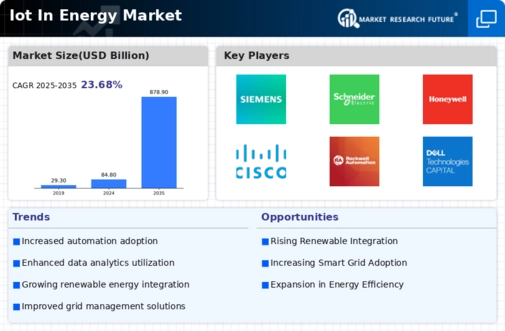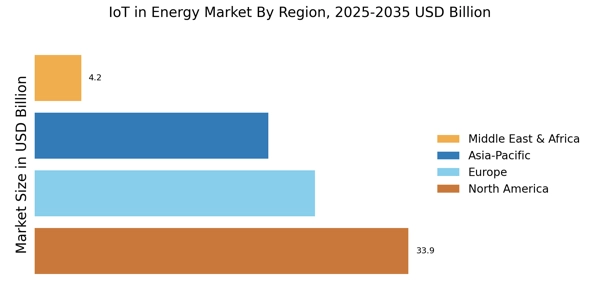Enhanced Grid Management
The modernization of energy grids is a critical factor driving the IoT in Energy Market. Smart grids, equipped with IoT technologies, enable utilities to monitor and manage energy distribution more effectively. This capability leads to improved reliability and reduced outages, which are essential for maintaining customer satisfaction. Data suggests that investments in smart grid technologies could exceed 100 billion dollars by 2025. The integration of IoT devices allows for real-time data collection and analysis, facilitating proactive maintenance and operational efficiency. As utilities seek to enhance grid resilience and accommodate the growing demand for electricity, the IoT in Energy Market stands to gain significantly from these advancements.
Increased Energy Efficiency
The IoT in Energy Market is witnessing a surge in demand for energy-efficient solutions. With the integration of IoT technologies, energy consumption can be monitored and optimized in real-time. This capability allows for the identification of inefficiencies and the implementation of corrective measures. According to recent data, energy efficiency improvements could lead to a reduction in energy consumption by up to 30% in certain sectors. As organizations strive to meet sustainability goals, the adoption of IoT solutions becomes imperative. The IoT in Energy Market is thus positioned to benefit from this trend, as stakeholders seek to leverage technology to enhance operational efficiency and reduce costs.
Regulatory Support and Incentives
Government policies and regulations play a crucial role in shaping the IoT in Energy Market. Many governments are implementing supportive frameworks and incentives to encourage the adoption of IoT technologies in energy management. These initiatives often include tax breaks, grants, and subsidies aimed at promoting energy efficiency and renewable energy integration. For instance, regulatory bodies are increasingly mandating the installation of smart meters, which are integral to IoT solutions. This regulatory environment not only fosters innovation but also drives investment in the IoT in Energy Market, as companies seek to comply with new standards and capitalize on available incentives.
Growing Adoption of Renewable Energy Sources
The transition towards renewable energy sources is a pivotal driver in the IoT in Energy Market. As countries commit to reducing carbon emissions, the integration of IoT technologies with renewable energy systems becomes increasingly vital. IoT solutions facilitate the management of energy generation from sources such as solar and wind, optimizing their output and reliability. Data indicates that the share of renewables in the energy mix is expected to reach 50% by 2030 in many regions. This shift not only supports environmental goals but also enhances energy security. Consequently, the IoT in Energy Market is likely to experience robust growth as it aligns with the global push for cleaner energy alternatives.
Rising Consumer Demand for Smart Energy Solutions
Consumer preferences are evolving, with a marked increase in demand for smart energy solutions within the IoT in Energy Market. As individuals become more environmentally conscious, they seek technologies that allow for better energy management in their homes and businesses. Smart home devices, such as smart thermostats and energy monitoring systems, are gaining traction, enabling users to optimize their energy usage. Market data indicates that the smart home market is projected to grow significantly, with energy management solutions being a key segment. This shift in consumer behavior is likely to drive innovation and investment in the IoT in Energy Market, as companies strive to meet the growing expectations for smart, efficient energy solutions.


















Leave a Comment